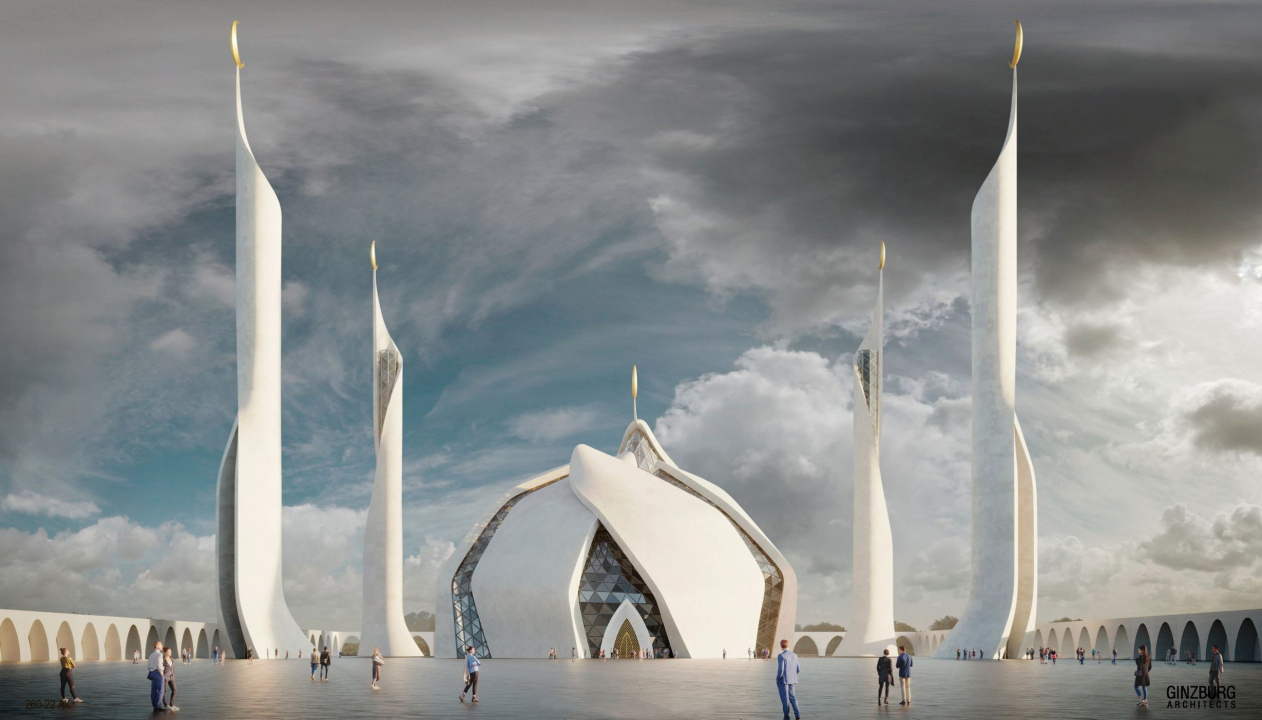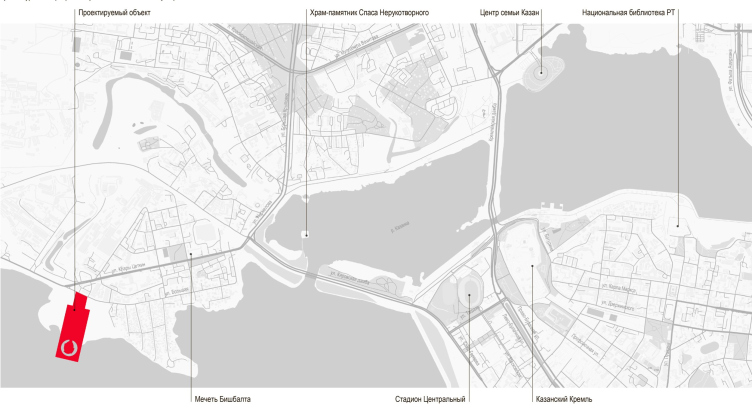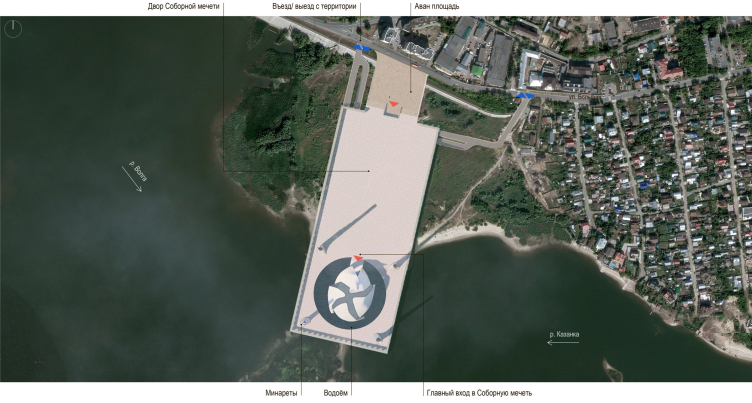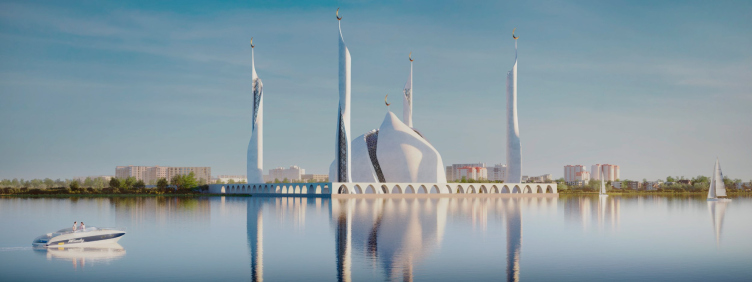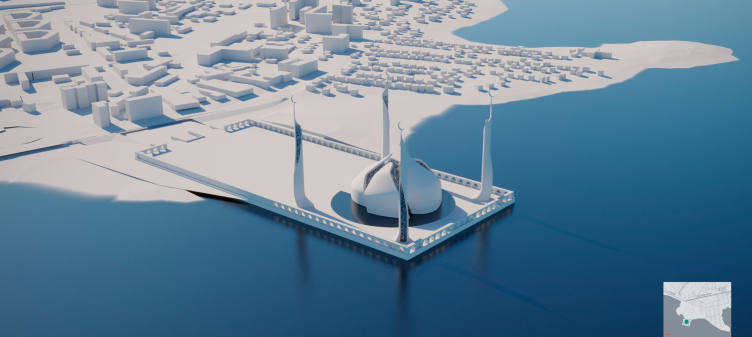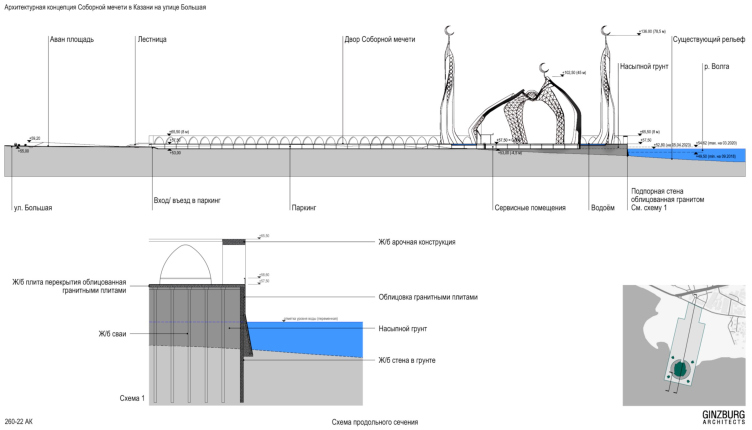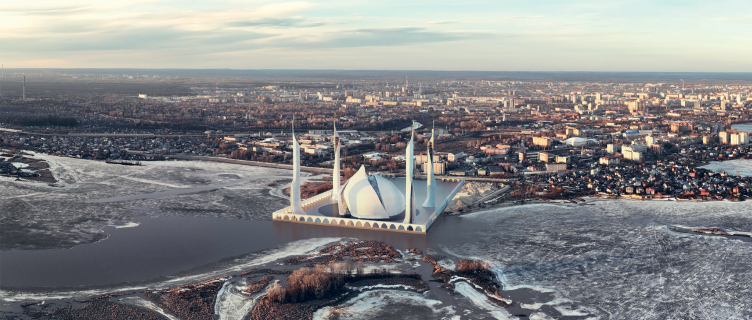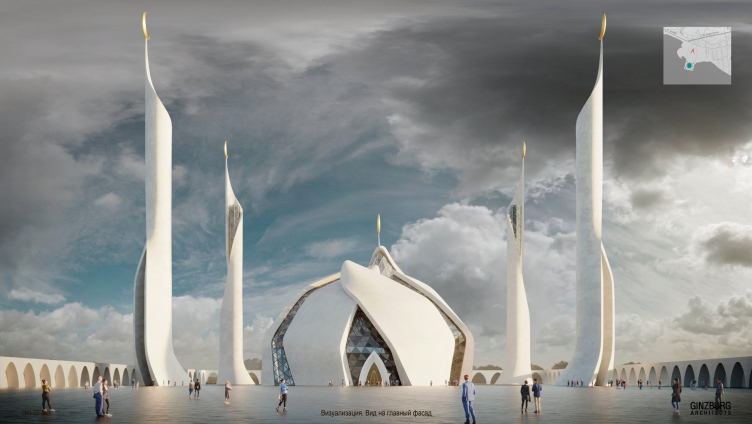Then, virtually without making any announcements, the city considered a few new locations for the construction of the anniversary mosque. Specifically, according to the 116.ru website, three locations were considered: one in the eastern part of Kazan in the Troitsky forest, one south of the Kremlin near the River Station on the left bank of the Volga, and one next to the Park of Newlyweds.
The third location – one in Admiralteiskaya Sloboda, on the cape where the old riverbed of the Kazanka joins the Volga – became the main one in May 2023.
“AK LALE” Cathedral Mosque
For this location, two projects were announced, upon which their authors had been working – as far as I am informed – since February 2023. One of the projects was authored by the winner of the competition 2022, Aleksey Ginzburg, who throughout fall and winter worked upon adapting his competition proposal for other locations, and in spring came with a totally different concept for Admiralteiskaya Sloboda. The other project was by Alexander Tsimailo and Nikolai Lyashenko, upon which, according to the architects, they worked at the commission of the republic’s president, Rustam Minnikhanov. The concept was presented at Arch Moscow, at the “Architect of the Year” TsLP booth (check out here and here).
Alexei Ginzburg’s project was published on the company’s website in the first decade of May, and received less publicity. Now we are telling you about it. What the two projects have in common is the plot, the capacity of the mosque, and the rectangular platform on the water; then the differences begin: the first project proposed a black Kaaba, the second – AK LALE – a white tulip.
Let’s, however, say a few words about the location first.
“AK LALE” Cathedral Mosque
The site is a rounded cape. To the east, there is a housing estate, north, there is Clara Zetkin Street, then, two kilometers away, there is the railway station “Admiralteyskaya Sloboda”. This place is essentially countryside, although the Kazan Kremlin is still viewable from here. The context here is not so much urban as of the riverside type: the Volga in front of the Kremlin makes a 90° turn, flowing from the west and turning to the south. In addition, the river is rather wide here – the reason for that being the Kuibyshev reservoir, located downstream in front of Ulyanovsk. After the creation of reservoirs, the Volga changed the shape of its riverbed in many locations, so there are its flood lands and backwaters here as well. Looking at the satellite images, one can see that the cape in question – the future mosque site – is 140 meters away from the Kamenny (“Stone”) Island that is partially flooded. And there are two channels of the Kazanka River, the old and the new.
Situated on such a water surface, the Cathedral Mosque will become the “gate” to the city, a landmark from the side of the river. At the same time, the cape should be viewable from the Kremlin, elevated on a tall hill.
Alexsey Ginzburg
The new site has completely different characteristics, and we understood that it would be impossible and even wrong trying to adapt our first project to it. So when we were asked to think about an option for Admiralteyskaya Sloboda, we proposed a whole new idea, which comes from the urban planning features of the new site. The building can be seen from afar, from the river as well as from the city – in our opinion, it should have an iconic silhouette that is easily readable and recognizable from afar.
That is why we offered the idea of a “tulip” building with four minarets: it correlates with the silhouettes of the most famous mosques; it allows you to make the main sculptural accent of the prayer hall volume; and finally it does not exclude the modern form that we tried to “mold” as being flowing and visually mobile, especially if we are to consider the building in motion, for example, when cruising down the river. At the same time, the symmetry of its composition works beautifully for representativeness and solemnity of the image, which is appropriate based on the anniversary meaning of the project and its significant scale.
That is why we offered the idea of a “tulip” building with four minarets: it correlates with the silhouettes of the most famous mosques; it allows you to make the main sculptural accent of the prayer hall volume; and finally it does not exclude the modern form that we tried to “mold” as being flowing and visually mobile, especially if we are to consider the building in motion, for example, when cruising down the river. At the same time, the symmetry of its composition works beautifully for representativeness and solemnity of the image, which is appropriate based on the anniversary meaning of the project and its significant scale.
So! The mosque is placed on a rectangular platform that is “rooted” in the bank part and protrudes in the direction of the river, forming an effect of a building that “floats” on the water, and picking up all the reflections you can possibly think of – the river is quite wide at this point.
“AK LALE” Cathedral Mosque
Copyright: © Ginzburg Architects
“AK LALE” Cathedral Mosque
Copyright: © Ginzburg Architects
The platform is embraced by an arched structure that does not obscure views from the plaza around the mosque, at the same time providing a rather austere orthogonal contour that puts you in the mind of the Sinan mosques of Istanbul – those are also built of light-colored stone, have a dome shape and a fence that ensures a confident distance. Inside of the platform, from the side of the dry land, there will be a parking lot; in addition, some of the earth will be built up and propped up by a concrete wall.
“AK LALE” Cathedral Mosque
Copyright: © Ginzburg Architects
“AK LALE” Cathedral Mosque
Copyright: © Ginzburg Architects
Unlike the austere contour of the arcade, the building is designed in the spirit of the approach that is commonly described as a “non-linear” or a “sculpture” house. Both the dome hall of the mosque and the four minarets are formed by large planes of light color with noticeable thicknesses – full of plastique, but not exactly flowing, as is sometimes the case with modern digital constructions.
You can easily imagine how these slabs are first flattened from sculptural modeling clay, and then are molded confidently and neatly, in a freehand manner, without any excessive dynamics. The architects make incisions in the “pipes” of the minarets, similar to the spring sprouts of some plants, superimposing giant petals on top of each other – for example, above the entrance. They “grow” the verticals of the minarets from a single “root” – at the bottom they all point toward the dome.
“AK LALE” Cathedral Mosque
Copyright: © Ginzburg Architects
“AK LALE” Cathedral Mosque
Copyright: © Ginzburg Architects
Meanwhile, we cannot say that the “biological” associations are literal, but rather that they form a vital energy, a kind of subtext of the form. Of course, we are facing a flower, but at the same time we are facing the sign of a flower.
Abstraction is further enhanced by the large form, generalization and, of course, the symmetry of the entire composition and the spiraling centripetal nature of the main volume. Minarets, paying tribute to the “root” center, then turn into slender verticals, hugging the rods of glass structures, glowing, like glass shafts between the “petals”.
On the inside, the petals are covered with quotations from the Koran in Arabic; between them, there is a combination of triangles of structural glazing. Accordingly, here you get a hall that is well illuminated and permeated by natural light in the daytime.
The entire form – the white petals and the intricately curved glass structures – is an integral shell, calculated through BIM and based on metal structures (including ball-and-stick ones) that combine round and rectangular bars and hidden joints of structural stained glass frames. So we are not seeing a mass, as it may at first seem, but a grid that forms the desired plastique: both the petals and the glass form a single integral structure.
The symbolism of the form is obvious: the tulip is worshiped in the Islamic world because its Arabic name, “lale”, consists of the same letters as the name of God, Allah. Hence the frequent appearance of tulips in Arabic ornaments, especially in combination with the crescent, which also has the same letters as the name of Allah. The white color is interpreted as a sign of purity of intentions. All this creates quite a literal figurativeness, the transformation of a symbol into a form – historical mosques were decorated with tulip flowers, and here the building itself is a flower – which falls in line both with the anniversary sense of the construction, and with the spirit of modern architecture, where small forms are often transformed into larger ones.
If we are to speak about the contemporary architectural context, the project fully fits into it as well, as it develops the direction started by Oscar Niemeyer – the petals and stained-glass windows between them remind the Brasilia Cathedral (1958-1970) – and the trend continued by masters of neo-modernist deconstruction of the early 2000s. Ayvar Sattarov, the winner of the second place in the 2022 competition, author of the Kremlin’s Kul Sharif Mosque, cites an analogy to the White Rose Mosque project proposed in 2014 by architect Festim Toshi for Tirana city center (the project was not implemented, as they built the traditional “Sinan” mosque instead), but the similarity here lies primarily in the “flower” theme; besides, in the rest of the Muslim world the approach of sculpting a modern building out of sculptural “shells” connected by glass fills has been popular for quite some time. In addition to Niemeyer, the Sydney Opera House designed by Jorn Watson certainly plays a big role in shaping it. Closer examples include Paul Paul Böhm’s Mosque in Cologne built in 2017 (while this may not be the most charming building on this list, it is still a good demonstration of the variability of the approach) or, more related in form, the Bahai temple in South America designed by Hariri Pontarini (2002-2016).
In other words, the context is rather wide – “sculpture” buildings and “flower” buildings have been around for at least 60 years now. You cannot call this project hyper-innovative – but the idea behind it develops a modern trend that definitely makes it possible to create a bright and memorable landmark with a clear agenda on the river in front of the city.
Now we will closely monitor the development of the design process of the Great Cathedral Mosque – one way or another, this is a very ambitious project.

